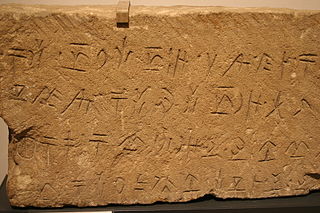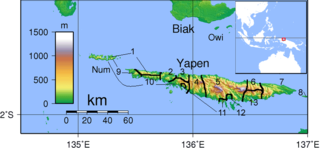Related Research Articles

Malay is an Austronesian language that is an official language of Brunei, Indonesia, Malaysia, and Singapore, and that is also spoken in East Timor and parts of Thailand. Altogether, it is spoken by 290 million people across Maritime Southeast Asia.

An endangered language or moribund language is a language that is at risk of disappearing as its speakers die out or shift to speaking other languages. Language loss occurs when the language has no more native speakers and becomes a "dead language". If no one can speak the language at all, it becomes an "extinct language". A dead language may still be studied through recordings or writings, but it is still dead or extinct unless there are fluent speakers. Although languages have always become extinct throughout human history, they are currently dying at an accelerated rate because of globalization, mass migration, cultural replacement, imperialism, neocolonialism and linguicide.

An extinct language is a language with no living descendants that no longer has any first-language or second-language speakers. In contrast, a dead language is a language that no longer has any first-language speakers, but does have second-language speakers or is used fluently in written form, such as Latin. A dormant language is a dead language that still serves as a symbol of ethnic identity to an ethnic group; these languages are often undergoing a process of revitalisation. Languages that have first-language speakers are known as modern or living languages to contrast them with dead languages, especially in educational contexts.
Lists of endangered languages are mainly based on the definitions used by UNESCO. In order to be listed, a language must be classified as "endangered" in a cited academic source. Researchers have concluded that in less than one hundred years, almost half of the languages known today will be lost forever. The lists are organized by region.

South Sulawesi is a province in the southern peninsula of Sulawesi, Indonesia. The Selayar Islands archipelago to the south of Sulawesi is also part of the province. The capital and largest city is Makassar. The province is bordered by Central Sulawesi and West Sulawesi to the north, the Gulf of Bone and Southeast Sulawesi to the east, Makassar Strait to the west, and Flores Sea to the south.

Portuguese creoles are creole languages which have Portuguese as their substantial lexifier. The most widely-spoken creoles influenced by Portuguese are Cape Verdean Creole, Guinea-Bissau Creole and Papiamento.

There are some 130 to 195 languages spoken in the Philippines, depending on the method of classification. Almost all are Malayo-Polynesian languages native to the archipelago. A number of Spanish-influenced creole varieties generally called Chavacano along with some local varieties of Chinese are also spoken in certain communities. The 1987 constitution designates Filipino, a standardized version of Tagalog, as the national language and an official language along with English. Filipino is regulated by Commission on the Filipino Language and serves as a lingua franca used by Filipinos of various ethnolinguistic backgrounds.

Mardijker is an extinct Portuguese-based creole of Jakarta. It was the native tongue of the Mardijker people. The language was introduced with the establishment of the Dutch settlement of Batavia ; the Dutch brought in slaves from the colonies they had recently acquired from the Portuguese, and the slaves' Portuguese creole became the lingua franca of the new city. The name is Dutch for "freeman", as the slaves were freed soon after their settlement. The language was replaced by Betawi creole Malay in Batavia by the end of the 18th century, as the Mardijker intermarried and lost their distinct identity. However, around 1670 a group of 150 were moved to what is now the village and suburb of Tugu, where they retained their language, there known as Papiá, until the 1940s.
The Central Maluku languages are a proposed subgroup of the Central–Eastern Malayo-Polynesian branch of the Austronesian language family which comprises around fifty languages spoken principally on the Seram, Buru, Ambon, Kei, and the Sula Islands. None of the languages have as many as fifty thousand speakers, and several are extinct.

The Yapen languages are the branch of Malayo-Polynesian languages spoken on Yapen Island and the nearby isle of Cenderawasih Bay, both in Papua province of northeastern Indonesia.

Teluk Cenderawasih National Park is the largest marine national park of Indonesia, located in Cenderawasih Bay, south-east of Bird's Head Peninsula. It includes the islands of Mioswaar, Nusrowi Island, Roon, Rumberpon, Anggrameos and Yoop. The park protects a rich marine ecosystem, with over 150 recorded coral species, for which it is considered a potential World Heritage Site.
Kayeli is an extinct Austronesian language once used by the Kayeli people of the Indonesian island Buru. Two dialects were recognized, namely Leliali (Liliali) and Lumaete.
The Bima language, or Bimanese, is an Austronesian language spoken on the eastern half of Sumbawa Island, Indonesia, which it shares with speakers of the Sumbawa language. Bima territory includes the Sanggar Peninsula, where the extinct Papuan language Tambora was once spoken. Bima is an exonym; the autochthonous name for the territory is Mbojo and the language is referred to as Nggahi Mbojo. There are over half a million Bima speakers. Neither the Bima nor the Sumbawa people have alphabets of their own for they use the alphabets of the Bugis and the Malay language indifferently.
Mawes is an extinct Papuan language of Indonesia.
Luhu is an extinct Austronesian language spoken in the west of Seram Island in eastern Indonesia. It is spoken in Luhu village on Hoamoal Peninsula at the western end of Seram, and in Boano and Kelang islands, off the western tip of Seram Island.
Duriankari, or Duriankere, is a possibly extinct Papuan language of Indonesian Papua. It is associated with the village of Duriankari at the southern tip of the island of Salawati, which is part of the Raja Ampat Archipelago and is adjacent to the Bird's Head Peninsula of the West Papuan mainland.
Lengilu is a nearly extinct language of Indonesian Borneo. At present, there are only four native speakers of Lengilu.
Wamesa is an Austronesian language of Indonesian New Guinea, spoken across the neck of the Doberai Peninsula or Bird's Head. There are currently 5,000–8,000 speakers. While it was historically used as a lingua franca, it is currently considered an under-documented, endangered language. This means that fewer and fewer children have an active command of Wamesa. Instead, Papuan Malay has become increasingly dominant in the area.
Serua is an extinct Austronesian language originally spoken on Serua Island in Maluku, Indonesia. Speakers were relocated to Seram due to volcanic activity on Serua. The language continues in communities in Waipia in Seram, where the islanders were resettled, along with those also from Nila and Teun. Here, the older generation retained the island language as a strong form of identity. It was found to be extinct in 2024.
Hukumina is an extinct Austronesian language recently spoken in the northwest of Buru Island in the Maluku Islands of eastern Indonesia. It had one native speaker in 1989.
References
- ↑ Tandia at Ethnologue (16th ed., 2009)

- ↑ "Did you know Tandia is critically endangered?". endangeredlanguages.com.
- ↑ "11 Indigenous Languages Declared Extinct: Education Ministry". Jakarta Globe. 8 March 2024. Retrieved 10 September 2024.
{{cite web}}: CS1 maint: url-status (link)